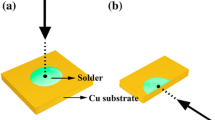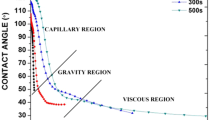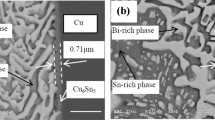Abstract
In electronics assembly, solder joints not only serve as mechanical supporters-, but also as heat removers. Therefore, solder joint reliability is a major concern not only during production, but also during the life time of electronic products. It can be pointed out that reliability of solder joint determines the lifetime of electronics products. This issue becomes more important with the use of Pb-free soldering alloys. This study focuses on the reliability of Sn–9Zn and Sn–8Zn–3Bi lead-free solder joints with Cu substrates. This study deals with interface intermetallic morphology, solder joint strength and fracture surface analysis after isothermal aging at 50, 100, and 150 °C for 100, 250, and 500 h. For all aging conditions, a flat Cu5Zn8 intermetallic was formed, and as the aging conditions increased, Cu atoms diffused through the intermetallic to form isolated Cu5Zn8 intermetallics in the bulk solder. Furthermore, Sn atoms from bulk the solder diffused through the intermetallic to form Cu6Sn5 on the Cu side. The formation of a thick Cu5Zn8 intermetallic and the diffusion of Sn and Zn atoms created a depletion zone near the solder/intermetallic boundary, which weakened the joint strength. As the intermetallic layer thickness increased, the joint strength decreased as the aging increased. The fracture path generally occurred at the bulk solder/intermetallic boundary under all aging conditions.
















Similar content being viewed by others
Research Data Policy and Data Availability Statements
The authors declare that the data supporting the findings of this study are available within the paper.
References
J. Chen, H. Zhang, P. Zhang, Z. Yu, Y. Zhang, C. Yu, H. Lu, The Zn accumulation behavior, phase evolution and void formation in Sn-xZn/Cu systems by considering trace Zn: a combined experimental and theoretical study. J. Market. Res. 8(5), 4141–4150 (2019)
S. Cheng, C.-M. Huang, M. Pecht, A review of lead-free solders for electronics applications. Microelectron. Reliab. 75, 77–95 (2017)
S.F. Choudhury, L. Ladani, Effect of intermetallic compounds on the thermo-mechanical fatigue life of the three- dimensional integrated circuit package microsolder bumps: finite element analysis and study. J. Electron. Packag. 137(4), 041003 (2015)
S.F. Choudhury, L. Ladani, Local shear stress-strain response of Sn–3.5Ag/Cu solder joint with high fraction of intermetallic compounds: experimental analysis. J. Alloy. Compd. 680, 665–676 (2016)
M.N. Collins, J. Punch, R. Coyle, Surface finish effect on reliability of SAC 305 soldered chip resistors. Solder. Surf. Mount Technol. 24(4), 240–248 (2012)
C.M. Gourlay, B. Arfaei, Advances in electronic interconnection materials. JOM 71(1), 131–132 (2019)
S.-H. Hu, T.-C. Lin, C.-L. Kao, F.-Y. Huang, Y.-Y. Tsai, S.-C. Hsiao, J.-C. Kuo, Effects of bismuth additions on mechanical property and microstructure of SAC-Bi solder joint under current stressing. Microelectron. Reliab. 117, 114041 (2021)
X. Hu, T. Xu, L.M. Keer, Y. Li, X. Jiang, Microstructure evolution and shear fracture behavior of aged Sn3Ag0.5Cu/Cu solder joints. Mater. Sci. Eng. A 673, 167–177 (2016)
S.H.A. Jaffery, M.F.M. Sabri, S. Rozali, S.W. Hasan, M.H. Mahdavifard, D.A.S. Al-Zubiady, B.R. Ravuri, Oxidation and wetting characteristics of lead-free Sn-0.7Cu solder alloys with the addition of Fe and Bi. Microelectron. Reliab. 139, 114802 (2022)
Y.-H. Ko, J.-D. Lee, T. Yoon, C.-W. Lee, T.-S. Kim, Controlling interfacial reactions and intermetallic Compound growth at the interface of a lead-free solder joint with layer-by-layer transferred graphene. ACS Appl. Mater. Interfaces 8(8), 5679–5686 (2016)
H. Li, R. An, C. Wang, Z. Jiang, In situ quantitative study of microstructural evolution at the interface of Sn3.0Ag0.5Cu/Cu solder joint during solid state aging. J. Alloy. Compd. 634, 94–98 (2015)
B. Liao, H. Wang, W. Xiao, Y. Cai, X. Guo, Recent advances in method of suppressing dendrite formation of tin-based solder alloys. J. Mater. Sci. Mater. Electron. 31, 13001–13010 (2020)
W. Liu, Y. Wang, Y. Ma, Q. Yu, Y. Huang, Interfacial microstructure evolution and shear behavior of Au–20Sn/(Sn)Cu solder joints bonded at 250 °C. Mater. Sci. Eng. A 651, 626–635 (2016)
L. Liu, P. Wu, W. Zhou, Effects of Cu on the interfacial reactions between Sn–8Zn–3Bi-xCu solders and Cu substrate. Microelectron. Reliab. 54(1), 259–264 (2014)
Y. Liu, F. Sun, Y. Liu, X. Li, Effect of Ni, Bi concentration on the microstructure and shear behavior of low-Ag SAC-Bi–Ni/Cu solder joints. J. Mater. Sci. Mater. Electron. 25, 2627–2633 (2014)
R. Mayappan, Z.A. Ahmad, Effect of Bi on the activation energy for the growth of Cu5Zn8 intermetallic in the Sn–Zn lead-free solder. Intermetallics 18(4), 730–735 (2010)
R. Mayappan, A.B. Ismail, Z.A. Ahmad, T. Ariga, L.B. Hussain, The effect of crosshead speed on the joint strength between Sn–Zn–Bi lead-free solders and Cu substrate. J. Alloy. Compd. 436(1–2), 112–117 (2007)
R. Mayappan, A.B. Ismail, Z.A. Ahmad, T. Ariga, L.B. Hussain, Effect of sample perimeter and temperature on Sn–Zn based lead-free solders. Mater. Lett. 60(19), 2383–2389 (2006)
Y. Mutoh, J. Zhao, Y. Miyashita, C. Kanchanomai, Fatigue crack growth behaviour of lead-containing and lead-free solders. Solder. Surf. Mount Technol. 14(3), 37–45 (2002)
H. Nishikawa, Y. Hirata, C.-H. Yang, S.-K. Lin, Effect of low Bi content on reliability of Sn-Bi Alloy joints before and after thermal aging. JOM 74(4), 1751–1759 (2022)
R. Pandher, R. Healey, Reliability of Pb-free solder alloys in demanding BGA and CSP applications, in 58th Electronic Components and Technology Conference IEEE, New York, (2008), pp. 2018–2023
G. Ren, M.N. Collins, On the mechanism of Sn tunnelling induced intermetallic formation between Sn–8Zn–3Bi solder alloys and Cu substrates. J. Alloy. Compd. 791, 559–566 (2019)
J. Shen, Y. Pu, D. Wu, Q. Tang, M. Zhao, Effects of minor Bi, Ni on the wetting properties, microstructures, and shear properties of Sn–0.7Cu lead-free solder joints. J. Mater. Sci. Mater. Electron. 26, 1572–1580 (2015)
K. Suganuma, K. Niihara, T. Shoutoku, Y. Nakamura, Wetting and interface microstructure between Sn–Zn binary alloys and Cu. J. Mater. Res. 13(10), 2859–2865 (1998)
W. Wang, Z. Chen, S. Wang, X. Long, Mechanics-based acceleration for estimating thermal fatigue life of electronic packaging structure. Microelectron. Reliab. 107, 113616 (2020)
M.-Y. Xiong, L. Zhang, Interface reaction and intermetallic compound growth behavior of Sn–Ag–Cu lead-free solder joints on different substrates in electronic packaging. J. Mater. Sci. 54(2), 1741–1768 (2019)
S. Zhang, X. Xu, T. Lin, P. He, Recent advances in nano-materials for packaging of electronic devices. J. Mater. Sci. Mater. Electron. 30(15), 13855–13868 (2019)
J. Zhao, Y. Mutoh, Y. Miyashita, S.L. Mannan, Fatigue crack-growth behavior of Sn–Ag–Cu and Sn–Ag–Cu-Bi lead-free solders. J. Electron. Mater. 31, 879–886 (2002)
J. Zhao, C.Q. Cheng, L. Qi, C.Y. Chi, Kinetics of intermetallic compound layers and shear strength in Bi-bearing SnAgCu/Cu soldering couples. J. Alloy. Compd. 473, 382–388 (2009)
J. Zhao, L. Qi, X.M. Wang, L. Wang, Influence of Bi on microstructures evolution and mechanical properties in Sn–Ag–Cu lead-free solder. J. Alloy. Compd. 375(1–2), 196–201 (2004)
Acknowledgements
This study was financially supported by the Ministry of Higher Education (MOHE) under Grant 600-RMI/FRGS 5/3 (104/2015). The author also thank the Universiti Teknologi MARA and Universiti Sains Malaysia for their facilities.
Funding
This work was supported by Ministry of Higher Education (MOHE) under Grant 600-RMI/FRGS 5/3 (104/2015).
Author information
Authors and Affiliations
Contributions
All authors contributed to this research. Material preparation, data collection, analysis and manuscript writing were performed Ramani Mayappan. Zainal Arifin Ahmad supervised the research and prove read the manuscript.
Corresponding author
Ethics declarations
Conflict of interest
The authors declare that they have no known competing financial interests or personal relationships that could have appeared to influence the work reported in this paper.
Human and Animal Rights Statement
All procedures performed in studies do not involve human participants.
Additional information
Publisher's Note
Springer Nature remains neutral with regard to jurisdictional claims in published maps and institutional affiliations.
Rights and permissions
Springer Nature or its licensor (e.g. a society or other partner) holds exclusive rights to this article under a publishing agreement with the author(s) or other rightsholder(s); author self-archiving of the accepted manuscript version of this article is solely governed by the terms of such publishing agreement and applicable law.
About this article
Cite this article
Mayappan, R., Ahmad, Z.A. Microstructure Evolution and Shear Strength Study of Sn–9Zn and Sn–8Zn–3Bi on Cu Substrate. Trans. Electr. Electron. Mater. 25, 48–58 (2024). https://doi.org/10.1007/s42341-023-00481-5
Received:
Revised:
Accepted:
Published:
Issue Date:
DOI: https://doi.org/10.1007/s42341-023-00481-5




